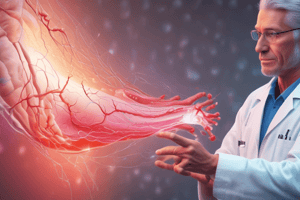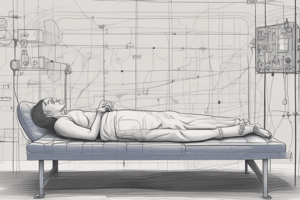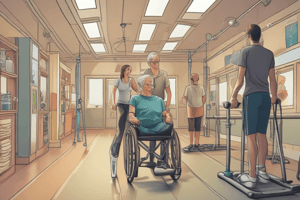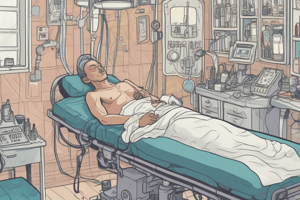Podcast
Questions and Answers
What is the primary role of the cerebellum in motor control?
What is the primary role of the cerebellum in motor control?
- To regulate muscle tone
- To initiate voluntary movement
- To compare movement to intended output and make predictive modifications///Movement coordination (correct)
- To control eye movement and gaze
What is a common cause of ataxia?
What is a common cause of ataxia?
- Damage to the cerebral cortex
- Damage to the spinal cord
- Damage to the cerebellum (correct)
- Damage to the basal ganglia
What is dysdiadochokinesia?
What is dysdiadochokinesia?
- Difficulty with rapid alternating movements (correct)
- Tremors or involuntary movements
- Impaired balance and postural control
- Weakness or lack of muscle tone
What is the primary goal of treatment for cerebellar damage?
What is the primary goal of treatment for cerebellar damage?
What is the role of the cerebellum in speech production?
What is the role of the cerebellum in speech production?
What is one of the effects of cerebellar dysfunction?
What is one of the effects of cerebellar dysfunction?
Which of the following is a mechanism of cerebellar damage?
Which of the following is a mechanism of cerebellar damage?
What is the purpose of the International Cooperative Ataxia Rating Scale (ICARS)?
What is the purpose of the International Cooperative Ataxia Rating Scale (ICARS)?
What is a common symptom of Ataxia?
What is a common symptom of Ataxia?
Which type of ataxia is characterized by autosomal dominant inheritance?
Which type of ataxia is characterized by autosomal dominant inheritance?
What is a compensatory strategy used to improve functional abilities in patients with cerebellar damage?
What is a compensatory strategy used to improve functional abilities in patients with cerebellar damage?
What is the primary function of the cerebellum in motor control?
What is the primary function of the cerebellum in motor control?
What is the term for the inability to perform rapid alternating movements?
What is the term for the inability to perform rapid alternating movements?
What is the primary role of the cerebellum in balance and equilibrium?
What is the primary role of the cerebellum in balance and equilibrium?
What is the term for the inability to coordinate voluntary movements?
What is the term for the inability to coordinate voluntary movements?
What is the primary function of the cerebellum in speech production?
What is the primary function of the cerebellum in speech production?
What is the primary focus of intensive long-term motor training in patients with cerebellar damage?
What is the primary focus of intensive long-term motor training in patients with cerebellar damage?
Which of the following is a degenerative mechanism of cerebellar damage?
Which of the following is a degenerative mechanism of cerebellar damage?
What is the purpose of using biofeedback and/or bandwidth feedback in the treatment of cerebellar damage?
What is the purpose of using biofeedback and/or bandwidth feedback in the treatment of cerebellar damage?
What is the effect of weighting on patients with cerebellar damage?
What is the effect of weighting on patients with cerebellar damage?
What is the primary goal of using resisted movements in the treatment of cerebellar damage?
What is the primary goal of using resisted movements in the treatment of cerebellar damage?
What is the benefit of using assistive devices with weights in patients with cerebellar damage?
What is the benefit of using assistive devices with weights in patients with cerebellar damage?
Study Notes
Neuroanatomy of Ataxia
- Ataxia is commonly caused by damage to the cerebellum
Role of Cerebellum in Motor Control
- Compares movement to intended output
- Predictive/anticipatory modifications in preparation for movement
- Motor learning: learns, memorizes, and stores motor programs
- Adaptation
Other Roles of Cerebellum
- Balance and equilibrium
- Control of muscle tone
- Accurate direction, extent, force, and timing of movement
- Movement composition
- Role in speech production
- Control of eye movement and gaze
Cerebellar Dysfunction
- Disorganization of movement, especially rapid movements
- Impaired balance
- Impaired postural control
- Hypotonicity
- Dysmetria
- Decomposition
- Ataxia
- Dysdiadochokinesia
- Tremor
- Asthenia
- Dysarthria
- Ocular dysmetria, nystagmus, etc.
Mechanisms of Cerebellar Damage
- Acquired: stroke, tumor, structural (Chiari malformation, agenesis, hypoplasia), toxicity (alcohol, heavy metals, drugs, solvents), immune-mediated (MS, gluten ataxia), trauma, infection (cerebellitis), endocrine (hypothyroidism)
- Degenerative: non-hereditary (multiple system atrophy, idiopathic late-onset cerebellar ataxia), hereditary (autosomal dominant disorders, autosomal recessive disorders, X-linked disorders)
Ataxia
- Without order or incoordination
- Slurred speech
- Stumbling, falling, incoordination
- Trouble eating and swallowing
- Eye movement abnormalities
- Tremors
- Cardiac issues
Outcome Measures
- Traditional function/activity measures (FIM)
- Balance/Postural control measures
- Gait measures
- Ataxia specific: International Cooperative Ataxia Rating Scale (ICARS), Scale for the Assessment and Rating of Ataxia (SARA)
Treatment
- Intensive long-term motor training
- Supervised as well as home exercise programs
- Intensive coordination training
- HEP focused on static and dynamic balance activities
- Sitting and standing
- Effect on walking: body weight supported treadmill training
- Use of biofeedback and/or bandwidth feedback
- Decreasing degrees of freedom
- Activities that focus on stability, co-contraction, midrange control
- Use of resisted movements
- Compensatory strategies: slow down movements, reduce number of segments moving at any given time, widen BOS, minimal environmental distractions, weighting (axial v limb), assistive devices, orthotics
Studying That Suits You
Use AI to generate personalized quizzes and flashcards to suit your learning preferences.
Related Documents
Description
Test your understanding of adult ataxia in neuromuscular practice, including neuroanatomy, causes, interventions, and management strategies. Explore the role of the cerebellum in motor control, balance, and motor learning.




